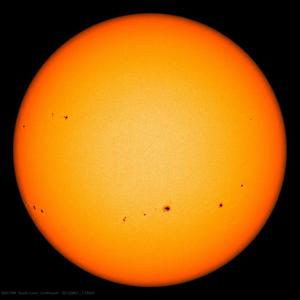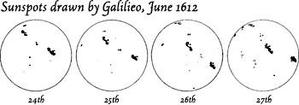Glossary term: Macchia solare
Description: Una macchia solare è una regione temporanea e fredda, causata da un forte campo magnetico nella fotosfera del Sole. Le macchie solari sono aree in cui tubi di flusso magnetico emergono dalle profondità del Sole. L'elevato campo magnetico aumenta la pressione magnetica in queste regioni. Per mantenere la stessa pressione dell'ambiente circostante, la pressione del gas e del plasma nella macchia solare deve diminuire, rendendola più fredda dell'ambiente circostante. Essendo più fredde della fotosfera circostante, le macchie solari possono essere viste al telescopio come macchie scure sulla superficie del Sole. Le dimensioni delle macchie solari variano da decine di chilometri a oltre centomila chilometri. Possono persistere per periodi di tempo compresi tra alcuni giorni e diversi mesi. Il numero e la posizione delle macchie solari sul Sole variano nel corso del ciclo solare. Si ritiene che anche altre stelle presentino macchie causate dai loro campi magnetici.
Related Terms:
See this term in other languages
Term and definition status: The original definition of this term in English have been approved by a research astronomer and a teacher The translation of this term and its definition is still awaiting approval
The OAE Multilingual Glossary is a project of the IAU Office of Astronomy for Education (OAE) in collaboration with the IAU Office of Astronomy Outreach (OAO). The terms and definitions were chosen, written and reviewed by a collective effort from the OAE, the OAE Centers and Nodes, the OAE National Astronomy Education Coordinators (NAECs) and other volunteers. You can find a full list of credits here. All glossary terms and their definitions are released under a Creative Commons CC BY-4.0 license and should be credited to "IAU OAE".
Related Media
Macchie solari
Credit: NASA/SDO/HMI credit link
License: PD Public Domain icons
Related Activities
Measure the Sun's Rotation Period
astroEDU educational activity (links to astroEDU website) Description: Find out the Sun’s rotation period, applying the simple equation of average speed to a real astronomical case.License: CC-BY-4.0 Creative Commons Attribuzione 4.0 Internazionale (CC BY 4.0) icons
Tags: Hands-on , History , Experiment , Galileo , average speed Age Ranges: 16-19 Education Level: Secondary Areas of Learning: Social Research Costs: Low Cost Duration: 1 hour 30 mins Group Size: Group Skills: Analysing and interpreting data , Engaging in argument from evidence , Planning and carrying out investigations , Using mathematics and computational thinkingIs the Sun rotating? Follow the sunspots!
astroEDU educational activity (links to astroEDU website) Description: Like a "modern" Galileo, use true astronomical satellite observations to discover if the Sun (and other celestial objects) are rotating!License: CC-BY-4.0 Creative Commons Attribuzione 4.0 Internazionale (CC BY 4.0) icons
Tags: Hands-on , History , Experiment , Galileo Age Ranges: 12-14 , 14-16 , 16-19 Education Level: Middle School , Secondary Areas of Learning: Social Research Costs: Low Cost Duration: 1 hour Group Size: Group Skills: Analysing and interpreting data , Planning and carrying out investigations










